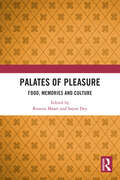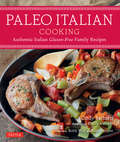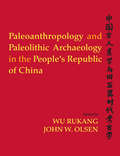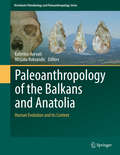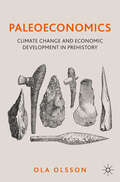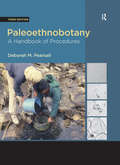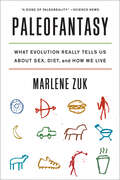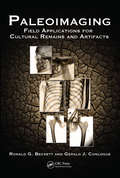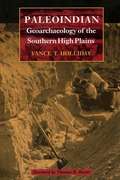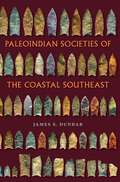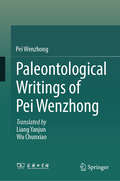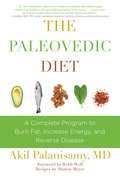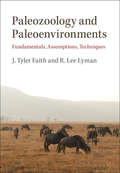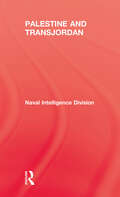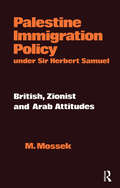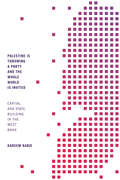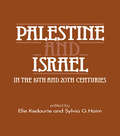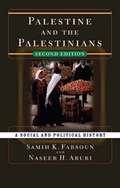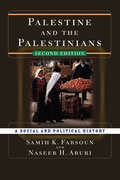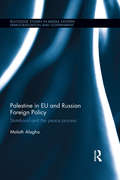- Table View
- List View
Palates of Pleasure: Food, Memories and Culture
by Rozena Maart and Sayan DeyThis book engages with the ways in which our habitual practices of cooking and eating uphold diverse forms of social, cultural, political, gendered, racialised, communal and geopolitical experiences of place and space. With diverse contributions from India, South Africa, Colombia, the United States, United Kingdom, and Jamaica, it discusses themes including modernity as a stuffed gourd; decolonising food in Colombia; culinary colonialism today; trijunction of colonialism, Hindu/India resistance, and hybridity; Hindu widows and forbidden food; Dutch colonisation of the Cape and its food sources in Bengal (India), Indonesia, and Malaysia; politicising the kitchens in India; and autoethnographic accounts of food, cooking, compliance and resistance, to underscore how patterns of cooking and eating build knowledge systems in daily life. The book also addresses the cultural and ethnic components of suppression, cultural expressions of food and belonging as is evidenced in Filipina American cultural identities marked by migration, pleasure and taste as a psycho-sexual construct at the Cape in South Africa where the enslaved understand the value of food and pleasure. This book will be of interest to scholars and researchers of cultural studies, philosophy, post-colonial studies, gender studies, food studies, food history, food anthropology, sociology, political sociology and social anthropology.
Pale Faces
by Charles L. BardesWho would have thought that something so commonplace as iron deficiency would lead to prehistoric ochre, Egyptian amulets, Renaissance alchemy, Victorian projections of maidenhood, and the astrophysical end of everything?Whether mild or deadly, anemia affects an essential body fluid: blood. In Pale Faces, Charles L. Bardes probes deeply into this illness as metaphor by exploring the impact of both science and culture on its treatment across the ages. His innovative "life" of this condition ranges widely through history, mythology, literature and clinical practice to examine how our notions of specific medical conditions are often deeply rooted in language, symbolism and culture.Delving into the annals of anemia and its treatment, he takes us on a fascinating journey back through the history of medicine-from the Greeks and ancient practices of bloodletting and magic up to the diagnostic rituals of a modern medical office. A scholar of the literary as well as the medical arts, Bardes gives us a beautifully written, free-ranging text, resonant with poetic associations yet anchored in concrete clinical experience.As a practicing physician, Bardes is also able to draw upon his direct experience with patients to demystify the doctor/patient relationship. Through detailed descriptions of the diagnostic processes involved in blood related conditions, as well as the particular understanding of the inner workings of the human body provided by modern medical science, we are treated to the complex ways in which doctors think.Charles L. Bardes, MD, is a practicing physician who teaches extensively at Weill Cornell Medical College, where he directs the Medicine Clerkship and serves as Associate Dean. He is the author of Essential Skills in Clinical Medicine, a guide for students and interns, and Pale Faces: The Masks of Anemia, the first book in the Bellevue Literary Press Pathographies series. He has been the Bernard DeVoto Fellow in Nonfiction at the Bread Loaf Writers' Conference and his essays have appeared in numerous journals, including Agni. He lives in New York.
Pale Horse Rider: William Cooper, the Rise of Conspiracy, and the Fall of Trust in America
by Mark JacobsonWe are living in a time of unprecedented distrust in America: Faith in the government is at an all-time low, and political groups on both sides of the aisle are able to tout preposterous conspiracy theories as gospel, without much opposition. “Fake news” is the order of the day. This book is about a man to whom all of it points, the greatest conspiracist of this generation and a man you may not have heard of. A former U.S. naval intelligence worker, Milton William Cooper published his manifesto Behold a Pale Horse in 1991. Since then it has gone on to sell hundreds of thousands of copies, becoming the number-one bestseller in the American prison system. (Bookscan lists sales at 289,000 since 2005.) According to Behold a Pale Horse, JFK was assassinated—because he was about to reveal that extraterrestrials were about to take over the earth—by his driver, an alien himself; AIDS is a government conspiracy to decrease the population of blacks, Hispanics, and homosexuals; and the Illuminati are secretly involved with the U.S. government to manage relationships with extraterrestrials. Cooper died in a shootout with Apache County police in 2001, one month after September 11, in the year in which he had predicted catastrophe. Many of Cooper’s conclusions were driven by personal demons and a highly creative connection of dots, and yet they have shaped much of the fabric of American life in the past few decades. Terry Nichols, Timothy McVeigh’s cohort in the Oklahoma City bombing, was a fan, and Behold a Pale Horse has great appeal among right-wing radicals. On the other hand, the book transcends class and race barriers: It is read primarily by poor blacks in prison and appeals to people who acutely feel that society is fixed against them. It has inspired numerous hip-hop groups and continues to do so. In Pale Horse Rider, journalist Mark Jacobson not only tells the story of Cooper’s fascinating life but also provides the social and political context for American paranoia. Indeed, with the present NSA situation and countless other shadowy government dealings often in the news, aren’t we right to suspect that things may not be as they seem?
Pale Rider: The Spanish Flu of 1918 and How It Changed the World
by Laura SpinneyIn 1918, the Italian-Americans of New York, the Yupik of Alaska and the Persians of Mashed had almost nothing in common except for a virus--one that triggered the worst pandemic of modern times and had a decisive effect on the history of the twentieth century. The flu pandemic of 1918-1920 was one of the greatest human disasters of all time. It infected a third of the people on Earth—from the poorest immigrants of New York City to the king of Spain, Franz Kafka, Mahatma Gandhi, and Woodrow Wilson. But despite a death toll of between 50 and 100 million people, it exists in our memory as an afterthought to World War I. In this gripping narrative history, Laura Spinney traces the overlooked pandemic to reveal how the virus traveled across the globe, exposing mankind&’s vulnerability and putting our ingenuity to the test. Drawing on the latest research in history, virology, epidemiology, psychology, and economics, Pale Rider masterfully recounts the little-known catastrophe that forever changed humanity.
Paleo Italian Cookbook
by Cindy BarbieriFrom her home to yours—Paleo Italian Cooking rounds up 100 authentic and easy-to-follow Italian recipes that allow you to eat a healthy Paleo diet—without even knowing it! Cookbook author and food blogger Cindy Barbieri discovered that she didn't have to reject her love of authentic Italian food when she decided to follow the Paleo approach to family dining. To her delight, she found her Nana's recipes, except for the pasta and Italian bread, were already healthy Paleo diet without even knowing it and those that were not inherently Paleo were easily converted with a few simple and healthy alterations—all without sacrificing the delicious flavors that shefell in love with as a child. Cindy's husband and kids enthusiastically embraced her nutritious and gluten-free Italian soups, salads, appetizers, entrees, sides and desserts—and your family will too! InPaleo Italian Cooking, Cindy shows you how to prepare many night's menus of authentic yet contemporary family-style Paleo Italian meals. Inspired by her annual trips to Italy and meals she makes for her family along with the memories of the meals she made with her Nana, Cindy will have you cooking Italian every night of the week with recipes like: Grilled Calamari Salad Tuscan Chicken & Vegetable Chili Chicken Scaloppine in Lemon-Caper Sauce Osso Buco Dover Sole Piccata Pistachio-Crusted Cod with Roasted Pepper Sauce Spaghetti Squash Puttanesca Porcini Mushroom & Peas Cauliflower "Risotto" Pistachio & Almond Biscotti Prosecco & Peach Cocktails Chocolate Pots de Creme You will be able to achieve a maximum level of health—while losing weight—without tedious calorie counting, purchasing expensive-but-bland prepared diet foods or skimping on the satisfying meals you crave. Simply by avoiding grains, legumes and pasteurized dairy you'll be able to trim down while filling up. Look and feel great while indulging your passion for Italian food!
Paleoanthropology and Paleolithic Archaeology in the People's Republic of China
by Wu Rukang; John W. OlsenThis book represents the first comprehensive attempt to bring to western scholarship the great advances made in Paleolithic archaeology and palaeoanthropology in the People’s Republic of China. The 15 chapters are devoted to a historical overview of past and recent studies, the development of chronological frameworks, the composition and stratigraphy of vertebrate fauna, the pongid and hominid palaeontological records, and Pleistocene prehistoric archaeology. Maps, illustrations and tables illustrate the materials presented here.
Paleoanthropology of the Balkans and Anatolia
by Katerina Harvati Mirjana RoksandicThis edited volume systematically reviews the evidence for early human presence in one of the most relevant geographic regions of Europe - the Balkans and Anatolia, an area that has been crucial in shaping the course of human evolution in Europe, but whose paleoanthropological record is poorly known. The primary aim of this book is to showcase new paleoanthropological (human paleontological and paleolithic) research conducted in the region. The volume is organized into three sections. The first one deals with the human fossil record from Greece, the Central Balkans, Croatia, Romania, Bulgaria and Turkey. The second section presents the paleolithic record of the same countries. In the third part, the authors provide a synthesis of current paleoenvironmental evidence for the Balkans. Chapters summarize and systematize the available human fossil evidence, examine their context, and place them within the framework of our understanding of human evolution in Europe and beyond, as well as present new analyses of existing human fossils. This book will be of interest to professionals, upper undergraduate and graduate students in paleoanthropology, human paleontology and paleolithic archaeology and in a variety of related fields, including human variation and adaptation, paleontology and biogeography. It will also be appropriate as a reference book for advanced undergraduate and graduate courses on human evolution and European paleoanthropology.
Paleoeconomics: Climate Change and Economic Development in Prehistory
by Ola OlssonThis accessible and insightful textbook provides a comprehensive introduction to the economics of prehistory. By presenting a chronological account of the beginnings of economics and human society, it charts the key developments in early human history, from the evolution of social norms and colonizing of unknown continents, to the development of early technology and the transition to agricultural food production. Particular attention is given to how human capital, the natural environment, social capital, and the spread of knowledge and technical skills propelled economic development during prehistory. The origin of modern concerns, including wealth inequality, stratified societies, and environmental change, are thoughtfully presented through the examining of the birth of the first states and human civilization. This book provides a thrilling account of human evolution and economic development from its African origins and hunter-gather days, through to the invention of agriculture and the rise of early states. Bringing together ideas from across economic history, the political economy, anthropology, and evolutionary biology, it will be relevant to students and general readers interested in these topics.
Paleoethnobotany: A Handbook of Procedures (The\missouri Archaeologist Ser. #Vol. 47)
by Deborah M PearsallThis new edition of the definitive work on doing paleoethnobotany brings the book up to date by incorporating new methods and examples of research, while preserving the overall organization and approach of the book to facilitate its use as a textbook. In addition to updates on the comprehensive discussions of macroremains, pollen, and phytoliths, this edition includes a chapter on starch analysis, the newest tool in the paleoethnobotanist's research kit. Other highlights include updated case studies; expanded discussions of deposition and preservation of archaeobotanical remains; updated historical overviews; new and updated techniques and approaches, including insights from experimental and ethnoarchaeological studies; and a current listing of electronic resources. Extensively illustrated, this will be the standard work on paleoethnobotany for a generation.
Paleofantasy: What Evolution Really Tells Us About Sex, Diet, And How We Live
by Marlene Zuk“With…evidence from recent genetic and anthropological research, [Zuk] offers a dose of paleoreality.” —Erin Wayman, Science News We evolved to eat berries rather than bagels, to live in mud huts rather than condos, to sprint barefoot rather than play football—or did we? Are our bodies and brains truly at odds with modern life? Although it may seem as though we have barely had time to shed our hunter-gatherer legacy, biologist Marlene Zuk reveals that the story is not so simple. Popular theories about how our ancestors lived—and why we should emulate them—are often based on speculation, not scientific evidence. Armed with a razor-sharp wit and brilliant, eye-opening research, Zuk takes us to the cutting edge of biology to show that evolution can work much faster than was previously realized, meaning that we are not biologically the same as our caveman ancestors. Contrary to what the glossy magazines would have us believe, we do not enjoy potato chips because they crunch just like the insects our forebears snacked on. And women don’t go into shoe-shopping frenzies because their prehistoric foremothers gathered resources for their clans. As Zuk compellingly argues, such beliefs incorrectly assume that we’re stuck—finished evolving—and have been for tens of thousands of years. She draws on fascinating evidence that examines everything from adults’ ability to drink milk to the texture of our ear wax to show that we’ve actually never stopped evolving. Our nostalgic visions of an ideal evolutionary past in which we ate, lived, and reproduced as we were “meant to” fail to recognize that we were never perfectly suited to our environment. Evolution is about change, and every organism is full of trade-offs. From debunking the caveman diet to unraveling gender stereotypes, Zuk delivers an engrossing analysis of widespread paleofantasies and the scientific evidence that undermines them, all the while broadening our understanding of our origins and what they can really tell us about our present and our future.
Paleoimaging: Field Applications for Cultural Remains and Artifacts
by Ronald G. Beckett Gerald J. ConlogueMedical and industrial imaging methods have come to be recognized as powerful tools for documentation and data collection in many nontraditional settings. In Paleoimaging: Field Applications for Cultural Remains and Artifacts, two of the most preeminent experts in the field provide an in-depth examination of a range of imaging techniques and explain how these techniques can be applied to all aspects of forensic and archaeological analysis.The first part of the book examines paleoimaging multimodalities, highlighting the advantages and disadvantages of each imaging technique in different scenarios. The authors explore photography, conventional radiography, endoscopy, and various forms of computer-based imaging. Next, they present methodological and procedural standards for the various imaging techniques. They also demonstrate how multimodal imaging can assist nondestructive data collection of non-biological cultural artefacts. A final section addresses radiation safety and field safety concerns. Case studies, tables, and templates of forms for documentation of findings enhance the text with practical information.Filled with over 380 images, this book is supplemented with an accompanying downloadable resource in which the authors draw from their global experience in the paleoimaging of cultural remains and artefacts, offering a view of the diverse environments in which field paleoimaging is conducted. The breadth of the authors’ expertise and the rich images contained in the book and downloadable resources make this resource an essential reference for those who seek to explore the mysteries of the past.
Paleoindian Geoarchaeology of the Southern High Plains
by Vance T. HollidayThe Southern High Plains of northwestern Texas and eastern New Mexico are rich in Paleoindian archaeological sites, including such well-known ones as Clovis, Lubbock Lake, Plainview, and Midland. These sites have been extensively researched over decades, not only by archaeologists but also by geoscientists, whose studies of soils and stratigraphy have yielded important information about cultural chronology and paleoenvironments across the region. In this book, Vance T. Holliday synthesizes the data from these earlier studies with his own recent research to offer the most current and comprehensive overview of the geoarchaeology of the Southern High Plains during the earliest human occupation. He delves into twenty sites in depth, integrating new and old data on site geomorphology, stratigraphy, soils, geochronology, and paleoenvironments. He also compares the Southern High Plains sites with other sites across the Great Plains, for a broader chronological and paleoenvironmental perspective. With over ninety photographs, maps, cross sections, diagrams, and artifact drawings, this book will be essential reading for geoarchaeologists, archaeologists, and Quaternary geoscientists, as well as avocational archaeologists who take part in Paleoindian site study throughout the American West.
Paleoindian Societies of the Coastal Southeast (Florida Museum of Natural History: Ripley P. Bullen Series)
by James S. DunbarThe late Pleistocene-early Holocene landscape hosted more species and greater numbers of them in the Southeast compared to any other region in North America at that time. Yet James Dunbar posits that a misguided reliance on using Old World origins to validate New World evidence has stalled research in this area. Rejecting the one-size-fits-all approach to Pleistocene archaeological sites, Dunbar analyzes five areas of contextual data—stratigraphy; chronology; paleoclimate; the combined consideration of habitat, resource availability, and subsistence; and artifacts and technology—to resolve unanswered questions surrounding the Paleoindian occupation of the Americas. Through his extensive research, Dunbar demonstrates a masterful understanding of the lifeways of the region’s people and the animals they hunted, showing that the geography and diversity of food sources was unique to that period. He suggests that the most important archaeological and paleontological resources in the Americas still remain undiscovered in Florida’s karst river basins. Building a case for the wealth of information yet to be unearthed, he provides a fresh perspective on the distant past and an original way of thinking about early life on the land mass we call Florida. A volume in the Florida Museum of Natural History: Ripley P. Bullen Series
Paleontological Writings of Pei Wenzhong
by Pei WenzhongThis book presents posthumously four research papers by the pioneer Chinese paleontologist Pei Wenzhong (1904-1982), mostly from the 1930s. The first chapter introduces Paleolithic art from European sites. Subsequent chapters give detailed technical descriptions of the formation, cultural findings, and fossils of principal Paleolithic sites in China, especially the Lower Paleolithic Choukoutien Peking Man site discovered in 1929 and the millennia later Upper Paleolithic Hetao (Ordos) Man site of the Ordos Loop of the Yellow River and the Upper Choukoutien Cave site. Cultural findings from the Peking Man site consist mainly in the use of fire and roughly manufactured stone tools. Those from the Hetao site indicate advances in group production and social organization. Those from the Upper Cave site consist of fine bone tools, along with pebble, bone, and shell ornaments, some polished and some dyed with hematite. The Upper Cave ancestors of the Chinese people had a prosperous clan society, buried their dead, acquired shells from 200 km away.
Paleovedic Diet: A Complete Program to Burn Fat, Increase Energy, and Reverse Disease
by Akil PalanisamyA groundbreaking total-body program that incorporates principles of Paleo nutrition, Ayurvedic medicine, and cutting-edge research. In The Paleovedic Diet, Dr. Akil Palanisamy, MD, offers a comprehensive roadmap to optimal health combining the most effective aspects of the Paleo diet with Ayurveda, the time-tested traditional medical system of India, and the latest scientific research. Making complex ideas understandable and accessible, Dr. Akil delivers a simple, customized diet and lifestyle program to fit your unique body type. Drawing upon on his extensive training and clinical experience, Dr. Akil skillfully separates fact from fiction, providing clarity on issues such as gluten sensitivity, misconceptions about carbs, meat-eating versus vegetarianism, good and bad fats, unknown superfoods (you’ll be surprised to see what’s included), nutritional supplements, and the critically important gut bacteria comprising your microbiome. The Paleovedic Diet provides definitive, practical guidance on what to eat, how to move, how to sleep, how to manage stress, and even how to breathe. Dr. Akil's revolutionary three-week program (with meal plan and recipes) utilizes delicious nourishing foods, powerful healing spices, and intensive detoxification techniques to help you transform your body and mind.
Paleozoology and Paleoenvironments: Fundamentals, Assumptions, Techniques
by R. Lee Lyman J. Tyler FaithPaleozoology and Paleoenvironments outlines the reconstruction of ancient climates, floras, and habitats on the basis of animal fossil remains recovered from archaeological and paleontological sites. In addition to outlining the ecological fundamentals and analytical assumptions attending such analyzes, J. Tyler Faith and R. Lee Lyman describe and critically evaluate many of the varied analytical techniques that have been applied to paleozoological remains for the purpose of paleoenvironmental reconstruction. These techniques range from analyses based on the presence or abundance of species in a fossil assemblage to those based on taxon-free ecological characterizations. All techniques are illustrated using faunal data from archaeological or paleontological contexts. Aimed at students and professionals, this volume will serve as fundamental resource for courses in zooarchaeology, paleontology, and paleoecology.
Palestine & Transjordan
by NavalFirst published in 2007. Routledge is an imprint of Taylor & Francis, an informa company.
Palestine 1917
by Robert WilsonA personal account of all ranks of the Yeomanry regiment, by a soldier who served in Sinai, Palestine and Syria. The Yeomanry regiments were originally raised in 1794, as a part of the volunteer forces, it was administered by the Home Office until 1855 when the War Office took over. The Yeomanry is most part consisted of the 'Yeoman of England, with noblemen and gentlemen as officers'. Wilson often touches upon the daunting conditions which were the ever-present background to the campaigns in which he took part. A likeable and remarkable character of the old yeoman class, his letters and correspondence notes the elation, dejection, of tedium and anxiety of desert warfare.
Palestine Immigration Policy Under Sir Herbert Samuel: British, Zionist and Arab Attitudes
by Moshe MossekAn analysis of the making of immigration policy during the first five years of the Civil Administration. This book examines the various bodies and individuals who took part in the creation of immigration policy, and the nature of such policy-making under the rule of Sir Herbert Samuel.
Palestine Is Throwing a Party and the Whole World Is Invited: Capital and State Building in the West Bank
by Kareem RabieIn 2008, Palestinian Prime Minister Salam Fayyad invited international investors to the first-ever Palestine Investment Conference, which was designed to jump-start the process of integrating Palestine into the global economy. As Fayyad described the conference, Palestine is “throwing a party, and the whole world is invited.” In this book Kareem Rabie examines how the conference and Fayyad's rhetoric represented a wider shift in economic and political practice in ways that oriented state-scale Palestinian politics toward neoliberal globalization rather than a diplomatic two-state solution. Rabie demonstrates that private firms, international aid organizations, and the Palestinian government in the West Bank focused on large-scale private housing development in an effort toward state-scale economic stability and market building. This approach reflected the belief that a thriving private economy would lead to a free and functioning Palestinian state. Yet, as Rabie contends, these investment-based policies have maintained the status quo of occupation and Palestine's subordinate and suspended political and economic relationship with Israel.
Palestine Jewry and the Arab Question, 1917-1925 (Routledge Library Editions: Israel and Palestine)
by Neil CaplanThis book, first published in 1978, examines the confrontation of the Jewish community of Palestine – the Yishuv – with its Arab question in the period immediately following World War 1, a period of excitement and uncertainty. Its main focus is on the different ways in which the men and women of the Yishuv perceived and defined the question of relations with the Arabs, and how they proposed to deal with the problems that arose.
Palestine and Israel in the 19th and 20th Centuries
by Elie Kedourie Sylvia G. HaimFirst Published in 1982. Middle Eastern Studies first appeared in 1964. The purpose of the Journal was the promotion of the study of the Middle East and North Africa since the end of the eighteenth century, and that it aimed to take within its ambit the political, economic, religious and legal history of the area, its literature, social geography, sociology and anthropology. That the Journal, now in its fourteenth volume, has been able to conform to this programme is due to its contributors who, over the years, have kept it supplied with a constant and abundant flow of articles on the various subjects here enumerated. This selection of articles on Palestine and Israel in the nineteenth and twentieth centuries, drawn from its first thirteen volumes, illustrates the great variety of subjects which authors have thought worth investigating, and the diversity of approaches which they have adopted. This book also shows that an appreciable part of the Journal, in terms simply of volume, has been devoted throughout to Palestine and Israel.
Palestine and the Palestinians: A Social and Political History
by Samih K. FarsounPalestine and the Palestinians is a sweeping social, economic, ideological, and political history of the Palestinian people, from antiquity to the Road Map to Peace. This second edition is thoroughly revised and updated, including entirely new chapters on the most current issues confronting Palestine today, including: Palestinians in Israel; the Oslo Accords and the Second Intifada; Palestinian refugees and the right to return; Jerusalem; the diplomatic "peace process" and two-state/single-state solutions.
Palestine and the Palestinians: A Social and Political History
by Samih K. FarsounPalestine and the Palestinians is a sweeping social, economic, ideological, and political history of the Palestinian people, from antiquity to the Road Map to Peace. This second edition is thoroughly revised and updated, including entirely new chapters on the most current issues confronting Palestine today, including: Palestinians in Israel; the Oslo Accords and the Second Intifada; Palestinian refugees and the right to return; Jerusalem; the diplomatic "peace process" and two-state/single-state solutions.
Palestine in EU and Russian Foreign Policy: Statehood and the Peace Process (Routledge Studies in Middle Eastern Democratization and Government)
by Malath AlaghaThe establishment of a Palestinian state has long been a strategic objective of EU and Russian foreign policy in the Middle East. However, over a decade after the creation of the road-map, the establishment of an independent Palestinian state has still not been achieved. Palestine in EU and Russian Foreign Policy uses the school of constructivism to provide a new understanding of EU and Russian foreign policy. It explores the failure of these global actors to speed up the process of establishing a Palestinian state, despite this being a strategic objective and top priority of their involvement in the Middle East peace process. The book then analyses the role of identity and self-other perception in the making of EU and Russian foreign policy towards the Middle East peace process. It is argued that Palestinian statehood provides a telling empirical example of how, and to what extent, the search for global actorness, as a matter of international identity, informs foreign policy-making by global actors. The book then proceeds to discuss why the EU and Russia are so eager to be involved in initiating a peace settlement. Offering a new understanding of foreign policy-making by global players in Middle Eastern politics, this book will appeal to students, scholars and policymakers working in International Relations and European, Russian and Middle Eastern studies.
